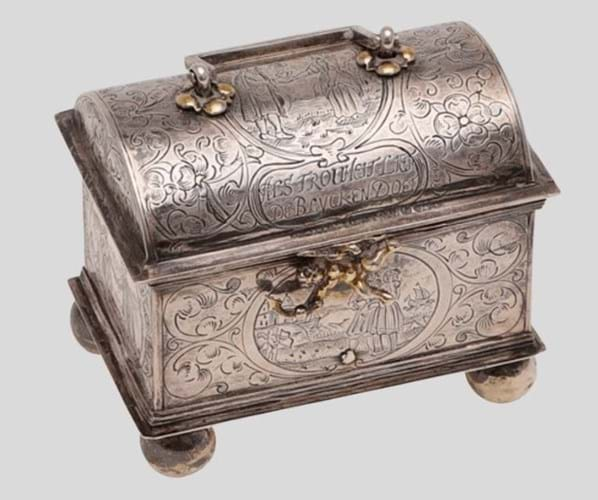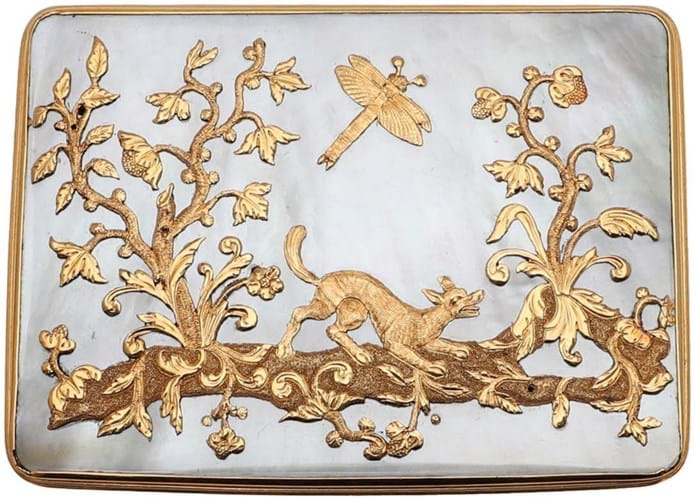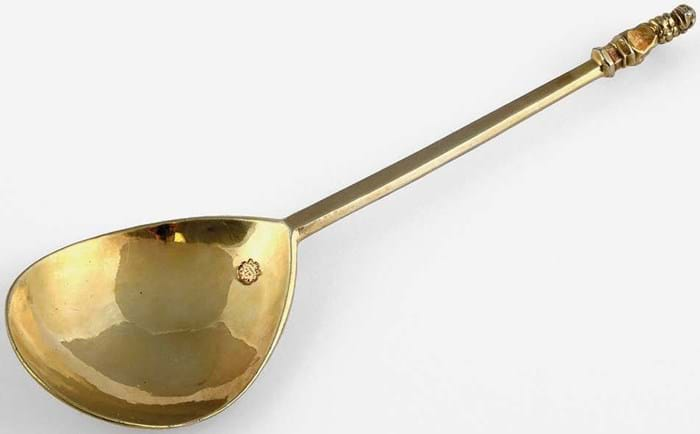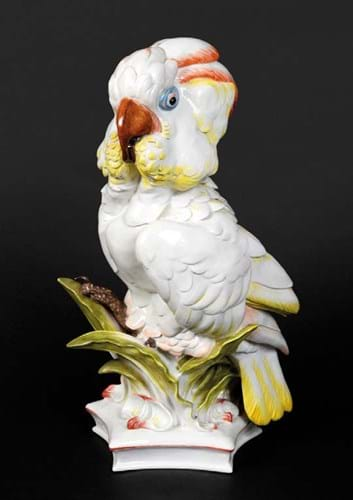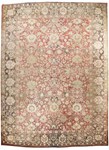The year began with a premium-inclusive £1m series of sales at Somerset auction house Lawrences (25% buyer’s premium).
First up at the Crewkerne saleroom was a 480-lot, £220,000 offering of silver and vertu on January 17 which had a 93% selling rate and a surprise top lot.
This was a 3in (7.5cm) long parcel-gilt Dutch marriage casket in the 17th century style engraved with couples in oval motifs. The locking mechanism, probably a replacement or repair, was mounted with a cupid.
The box, inscribed with the maker’s mark SA, was catalogued as a 19th century revivalist piece and pitched accordingly at £50-80.
After it went to an overseas collector at £7200, Lawrences’ recently appointed silver sales co-ordinator Connor Swanick said: “It was an attractive piece and presumably the buyer and underbidder thought it was older than we did.”
Up for Tuppy
Overseas private bidders were a major force throughout the sale.
Good things coming in little boxes included a 3¼in (8cm) diameter George III Irish freedom box and a 3in (7.5cm) long gold and mother-of-pearl snuff box.
The freedom box made by Abraham Tuppy, Dublin, c.1780, was engraved to the domed pull-over cover with the coat of arms and motto of Drogheda and to the base with the arms of motto for Brabazon, family name of the Earls of Meath.
Pitched at £1000-1500, it went to an Irish private bidder at £5000.
The Continental (possibly Italian) snuff box was unmarked and more of a puzzle but given a suggested date of c.1740. The hinged mother-of-pearl top was decorated with gold overlay with a fox among foliage apparently chasing a dragon fly.
“It was in good condition and provenanced to the private collection of the late John Taylor, which grossed more than £50,000 over 200 lots,” said Swanwick after the box went abroad at a seven-times estimate £4500.
The major surprise among the 100 lots of spoons was the George III dessert spoon featured in ATG No 2579 which owed its estimate-eclipsing £3000 to the crest of Horatio Nelson.
Collectors of earlier spoons were drawn to a private collection which included rarities in good condition.
A c.1597 seal-top with the maker’s mark of Robert Tyte of Salisbury was at the top of the table. Featuring a chased and fluted gilt terminal and with the scratched initial MB 27 Oct 1597, the 6½in (16.5cm) spoon quadrupled expectations, going overseas at £2400.
A similarly sized silver-gilt lion sejant spoon by William Cawdell, London 1603, was engraved on the reverse of the bowl with a coat of arms below two crests and motto Qua Pote Lucet. Estimated at £1200-1500, it sold to an American collector also at £2400 via thesaleroom.com.
Two Stuart apostle spoons, one by William Friend, London 1618, the other a silver-gilt work by Richard Crosse, London 1636, each went at around expectations at £1200 and a typically plain ‘Puritan’ spoon with a rudimentary rattail by Stephen Venables, London 1663, made £1400.
Above-estimate bids for antique English silver included £2700 on a two-handled bowl and cover by Digby Scott and Benjamin Smith, London 1803, and £2200 on a 3½in (9cm) high armorial mug by Benjamin Pyne, London 1693.
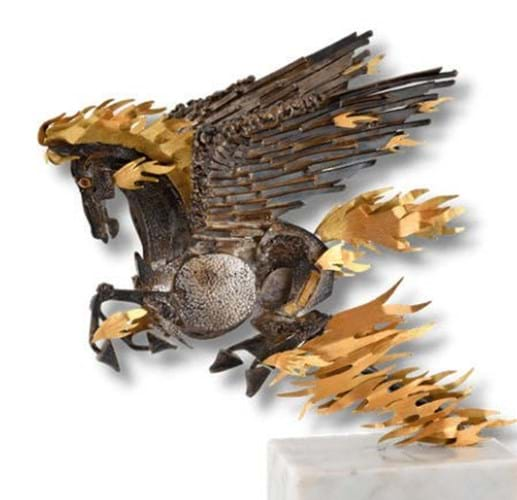
Pegasus II by Georges Weil, £3500 at Lawrences of Crewkerne.
Both were outsold by a modern piece: a 1970 two-colour centrepiece of a dragon by Austrian sculptor Georges Weil (b.1938).
Pegasus II featured a textured body, flashes of 18ct gold decoration and ruby eyes and, including the white marble base, stood 15½ in (39cm) high. Bearing a facsimile signature and numbered 40, it went to the UK trade at £3500, double the mid-estimate.
Dealer nets needlework
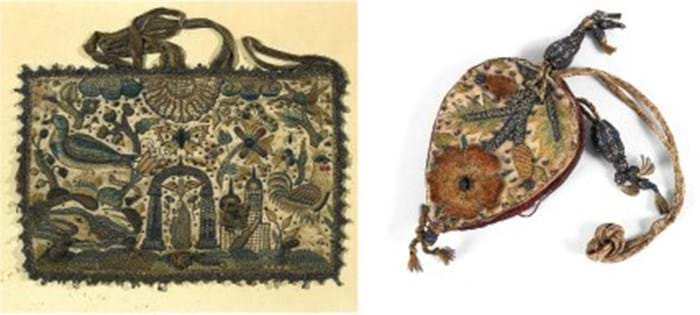
A c.1610-30 silk and metal thread needlework bag and purse, £8400 and £4800 respectively at Lawrences of Crewkerne.
The biggest money among the 350 lots of furniture, clocks and rugs offered at Crewkerne on January 20 was found in a purse and a needle bag. These early 17th century decorative needlework pieces from the same consignor each went to the same determined UK dealer.
First up was the 3½in (9cm) long heart-shaped purse worked coloured silk and metal thread with a flower spray on each side and tassel drawstring. Some small pieces of thread were missing or detached but it was in good condition for such a work done c.1610-30 and against a £400-600 estimate sold at £4800.
It was followed by the bag, similarly dated but larger at 7½ x 11in (19 x 28cm) and more elaborately worked with a figure beneath an arch surrounded by flowers, insects, a cockerel, a dove and what appears to be a whale.
Authenticated by George Wingfield-Digby, former keeper of the V&A textiles department, it was probably used as a protective cover for a silver chalice.
It had lost most of the sequins from the outer edge but, again, was in good condition for its age and more than quadrupled top hopes in selling at £8400.
Furniture sold steadily, if unspectacularly, with the favourite lot a cast-iron garden seat combining two major names: Christopher Dresser and Coalbrookdale.
The 6ft 6in (1.98m) wide, white-painted bench the Water Plant design required repainting but went comfortably above hopes at to an online UK private buyer at £3400.
Giuliano delights
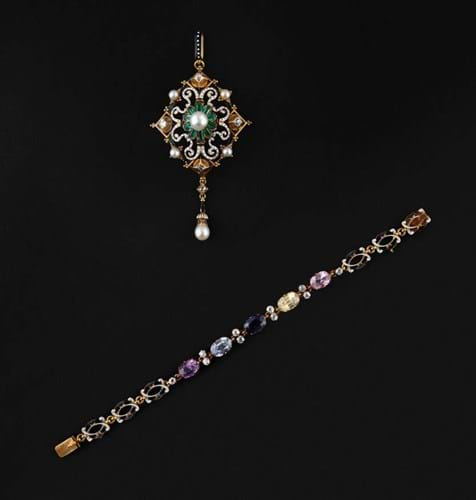
Enamelled and gem-set pendant and bracelet by the Giuliano family, £11,500 and £11,000 respectively at Lawrences of Crewkerne.
Jewellery offered on January 19 was led by two late 19th century pieces from the same vendor made by the Giuliano family, the Italian immigrants associated with Renaissance and Etruscan revival jewels.
Topping the day was an enamelled and gem-set pendant with maker’s plaque CG for Carlo Giuliano (1831-95) who arrived in London in about 1860 and, after working with leading jeweller Alessandro Castellani, set up his own retailers/workshop in Piccadilly.
At the Crewkerne sale the pendant, with emerald and pearl flowerhead cluster set rose-cut diamonds and pearls, in yellow gold was estimated at £5000-7000. It sold to the UK trade at £11,500.
Carlo was joined by his sons who, after their father’s death, renamed the company Carlo & Arthur Giuliano.
An enamel bracelet at Lawrences carried their makers’ mark C&AG. Mounted with five different coloured sapphires divided by pairs of rose-cut diamonds and with gold links,
the bracelet, estimated at £4000- 6000, went to another UK dealer at £11,000.
Large Meissen pieces
Two large pieces of 20th century ornithological Meissen took wings when they topped the ceramics sold along with pictures and modern design items on January 18.
The 18½in (47cm) tall model of a cockatoo was signed PW for Paul Walther, who joined the Dresden factory as a 15-year-old in 1891 and worked as a modeller until his death in 1933 with birds and animals his specialty. Marked with the blue crossed swords to one side and impressed 77295, 278G the cockatoo was in good condition and made a triple-estimate £3800.
The 12½in (32cm) elaborate case of an enamel-dial clock featured various birds including a parrot and cockatoo amid foliage. Two leaves were loose but, given its complexities, the clock, with impressed numbers 60817, has survived well. Pitched at £300-500 it sold at £1700. Both pieces went to overseas collectors.
One of the day’s best-sellers was a 9½ x 7½in (24 x 19cm) three-quarter length monochrome photograph of Winston Churchill beside his desk, signed to the mount Winston Churchill, 1944. Adding to that key selling point was a plaque on the 15 x 13in (38 x 33cm) oak and gilt frame reading Winston Churchill, June 12th 1944, Normandy and back and the photo’s provenance.
It had been acquired by Alfred Noyes, navigator on the destroyer HMS Kelvin when it ferried Churchill to the Normandy beachhead the week after D-Day.
There were some marks to the top of the photo, possibly water damage, and the mount was stained but it was in generally good condition and, against a £600-800 guide, went to a private bid from abroad at £8500.


